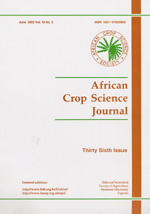
|
African Crop Science Journal
African Crop Science Society
ISSN: 1021-9730
EISSN: 1021-9730
Vol. 7, No. 4, 1999, pp. 511-522
|
 Bioline Code: cs99042
Bioline Code: cs99042
Full paper language: English
Document type: Research Article
Document available free of charge
|
|
|
African Crop Science Journal, Vol. 7, No. 4, 1999, pp. 511-522
| en |
Effects of Cassava Mosaic Virus Disease on the Growth and Yield of Cassava - Some Highlights from Makerere Experiments
Osiru, D.S.O.; Sserubombwe, W.S.; Sseruwagi, P.; Thresh, M. & Otim-Nape, G.W.
Abstract
A series of experiments is described in which the effects of cassava mosaic disease (CMD) on the growth and yield of cassava were evaluated. Four cassava varieties of differing resistance/susceptibility were used. These were Ebwanatereka (Susceptible local), Nase 2 (Moderately resistant/improved), SS4 and Migyera (Resistant/improved). The results showed significant differences between varieties and their mixtures both in the incidence and the amount of disease that developed. Ebwanatereka had the highest CMD incidence while SS4 had the lowest. Varietal mixtures consistently and significantly decreased the incidence of CMD and the population of adult whiteflies compared to their corresponding pure stand treatments. Stage of infection significantly affected the yield of the susceptible variety, Ebwanatereka. The earlier the infection, the greater was the effect of CMD. However, the stage of infection did not appear important in the resistant varieties. Compensation occurred in all varieties although significantly more compensation was achieved in Ebwanatereka. The health status of the immediate neighbours significantly influenced the losses sustained. Application of NPK fertiliser significantly increased the incidence of CMD in Nase 2 and Migyera compared with the unfertilised treatments. However, little difference was apparent in Ebwanatereka which became almost totally infected in all treatments. Adult whitefly populations were increased significantly by the application of NPK in Nase 2 and Ebwanatereka, whereas no effect was observed in Migyera. The implications of these findings in the epidemiology and management of CMD and the scope for future research are discussed.
Keywords
Bemisia tabaci, CMD, leaf area index, Uganda
|
| |
| fr |
Osiru, D.S.O.; Sserubombwe, W.S.; Sseruwagi, P.; Thresh, M. & Otim-Nape, G.W.
Résumé
Des séries d’essais sont décrites dans lesquels les effets de la maladie de la mosaïque du manioc sur la croissance et le rendement du manioc ont été évaluées. Quatre varietés de manioc de résistance/sensibilité variée ont été utilisées. Elles étaient Ebwanatereka (local sensible), Nase 2 (Modérément résistante/ améliorée), SS4 et Migyera (résistantes et améliorées). Les résultats ont montré des différences significatives entre les variétés et leurs mélanges dans la fréquence et la quantité de la maladie développée. Ebwanatereka a eu l’incidence la plus faible. Les mélanges variétaux ont consistement et significativement réduit l’incidence de CMD et la population de mouches blanches adultes comparés aux traitements correspendant en position pure. Le stade d’ infection a significativement affecté le rendement de la variété sensible Ebwanatereka. Cependant le stade d’infection n’a pas apparu important chez les variétés résistantes. La compensation s’est produite chez toutes les varietés bien qu’elle a été significativement plus considérable chez Ebwanatereka. L’état de santé des plantes avoisinates immédiates a influencé des pertes encourues. L’ application d’engrais NPK a augmenté l’incidence de CMD chez Nase 2 et Migyera comparée aux traitements non-fertilizés. Cependant, une petite différence a été apparente chez Ebwanatereka qui est devenue presque totallement infectée dans tous les traitements. Les populations adultes de mouches blanches ont été augmentées par l’application de NPK chez Nase 2 et Ebwanatereka. Les implications de ces résultats dans l’épidemiologies de la gestion de CMD et les perspectives futures de recherche sont discutées. Plus l’infection était précoce, plus important était l’effet de CMD.
Mots Clés
Bemisia tabaci, CMD, indice de la surface foliaire, Ouganda
|
| |
© Copyright 1999 - African Crop Science Society
|
|
